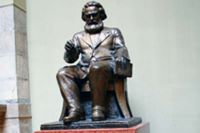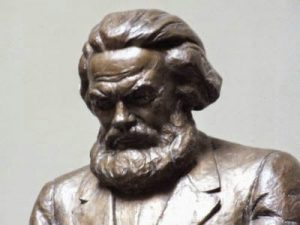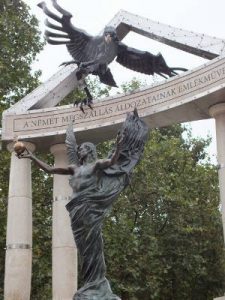The battle of memory that has been raging in Budapest over the past few months has claimed yet another victim: Karl Marx. His statue, enthroned in the former university of the same name (renamed Corvinus in the early days of the post-socialist transition), has just been removed. This action comes less than a month after the installation of the controversial German Occupation Memorial.
 On Sunday, September 14, 2014, a half-marathon took place in sunny Budapest, attracting over 12,000 participants and tens of thousands of supporters. The city of colorful facades was filled with an atmosphere of elation. At the same time, however, and almost unnoticed, not far from the 5th kilometer of the race, conflicts of memory were once again at work. Indeed, as if to take advantage of the distraction, the authorities had decided to have the famous statue of Karl Marx, located in the grounds of Corvinus University, removed at this very moment.
On Sunday, September 14, 2014, a half-marathon took place in sunny Budapest, attracting over 12,000 participants and tens of thousands of supporters. The city of colorful facades was filled with an atmosphere of elation. At the same time, however, and almost unnoticed, not far from the 5th kilometer of the race, conflicts of memory were once again at work. Indeed, as if to take advantage of the distraction, the authorities had decided to have the famous statue of Karl Marx, located in the grounds of Corvinus University, removed at this very moment.
Karl Marx unwanted
For several months already, the Christian Democrats (allies of FIDESZ and members of the majority coalition in Parliament) had launched a campaign of denigration against the historic figure of Marx, accusing him in particular of his “anti-Semitic and racist” ideology.

- The bust of Karl Marx in Corvinus University (photo: Assen Slim, September 13, 2014).
Looking gloomy and serious, Karl Marx appears preoccupied by the way the Hungarian memory debate is unfolding. For years, the faces of his friend Engels and Lenin were classics of socialist iconography. The removal of the statue was proposed as early as the 1990s, but university management stood firm, claiming that “removing the statue would in no way change the past.” In January 2014, Zsolt Rostovanyi, the current president of Corvinus University, reiterated that the choice of a new name for the institution was in itself a “radical change of direction,” but that the statue was part of the university’s history.
It was finally at the request of the Alliance of Young Christian Democrats (IKSZ) that the statue was removed from the University by the authorities. IKSZ leaders immediately welcomed the removal, noting that it symbolically marked the end of the post-communist era.
Since then, the University’s main entrance hall has seemed quite empty, and students initially wondered where the statue of the man whose works they are still studying had gone. Indeed, even if later interpretations of K. Marx’s ideas paved the way for the dictatorships of the 20th century, he remains a major author whose works are still studied at universities of economics, sociology, philosophy, and history all over the world, including Corvinus University in Budapest.

- The deserted site of the Marx statue (Photo: Robert Rahner, September 15, 2014).
A “great emptiness” and a “feeling of being fed up” - these were the words of the first Hungarians to arrive at the university the following day. Some decided to protest spontaneously, setting up on the now-empty site of the monument. Not claiming to belong to any political party or ideology, these citizens all insist on the importance of this statue in the history of their city and their country. The statue is gone, but the substance remains.
A controversial memorial to the German occupation
Sundays must be the day of choice for Hungary’s ruling majority. Indeed, it was on a Sunday (July 20, 2014, at 3 a.m.) that the monument to the German occupation was erected in Budapest’s Freedom Square. Prime Minister Viktor Orbàn has thus completed this controversial project(1). Numerous Hungarian and foreign historians, as well as the country’s Jewish organizations, had opposed the project, arguing that the monument blamed the Nazis alone for the mass deportations of Jews and failed to acknowledge the direct responsibility of the Horthy regime in 1944.

- The German Occupation Memorial (photo: Assen Slim, September 12, 2014).
The memorial depicts the Archangel Gabriel (symbolizing the Hungarian nation) against the background of an eagle (symbolizing Nazi Germany). The controversy stems from the fact that this representation overlooks a less flattering reality, since it was the Hungarian militia of the Horthy regime that deported over 70% of Hungary’s Jewish population in 1944.

- Memorial dedications (photo: Assen Slim, September 12, 2014).
The day after it was erected, the monument attracted many Hungarians, who came to deposit photos, shoes, identity papers, letters... in connection with the mass deportations of the summer of 1944. Since then, small stone altars have been installed around the monument in memory of the victims. The dedication In Memory of the Victims is engraved in the monument’s marble in several languages (Hungarian, English, Hebrew, German, Russian). Still, a Budapest rabbi pointed out in a radio interview that the Hebrew translation of the word “victim” was wrong and not used when referring to human beings.
Since then, the Liberty Square has rarely been empty, with one demonstration following another. Occasionally, a historian intervenes almost spontaneously before the crowd to tell the story of this tragic episode that the authorities want to distort.
Not only has police presence been increased all around the monument, but police teams have also been equipped with small, portable facial recognition cameras. The cameras are “American-made,” say some of the demonstrators. They don’t seem to discourage the demonstrators, who are more amused than annoyed by this close surveillance. It’s as if they wanted to believe that “Liberty” Square was not an empty word in Hungary.

- Police officers equipped with facial recognition cameras (photo: Assen Slim, September 12, 2014).
Note :
(1) See Assen Slim, “Budapest: lieux de tensions mémorielles,” Regard sur l’Est, June 1, 2014.
* Assen SLIM is a senior lecturer at INALCO. Blog.
Link to the French version of the article
Thumbnail: The Karl Marx statue on the grounds of Budapest’s Corvinus University before it was removed (photo: Assen Slim, September 13, 2014).
To cite this article: Assen SLIM (2014), “Budapest: memory hypertension,” Regard sur l’Est, October 1.
